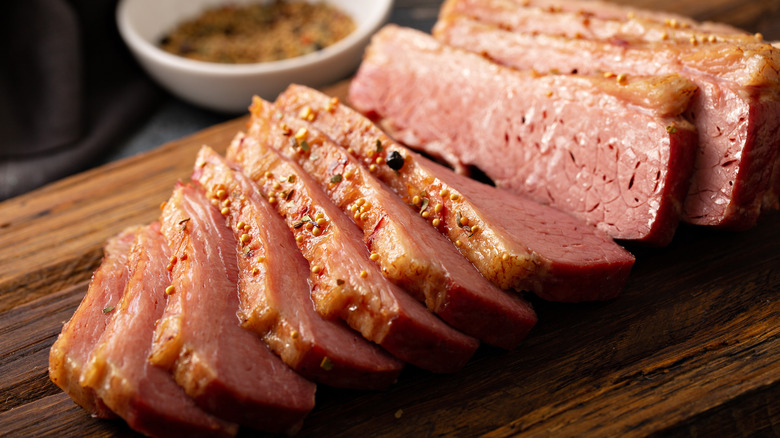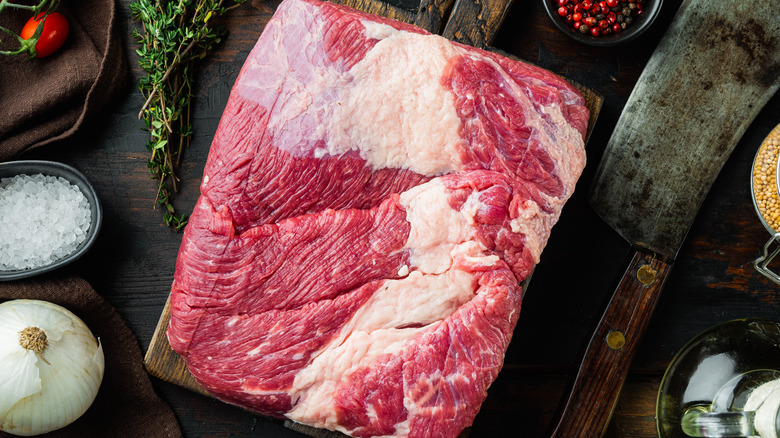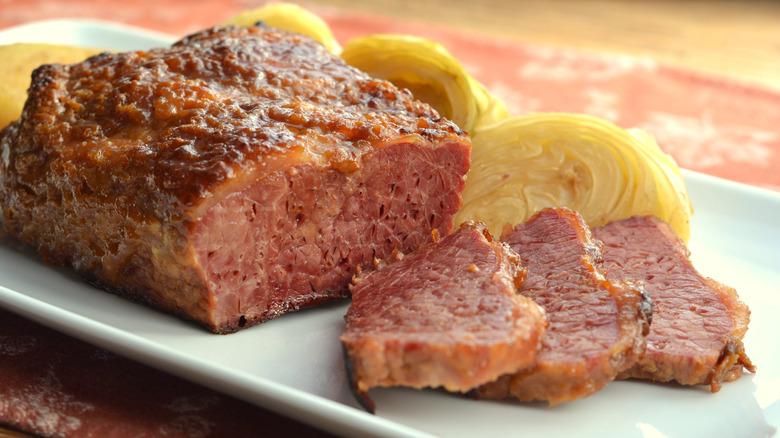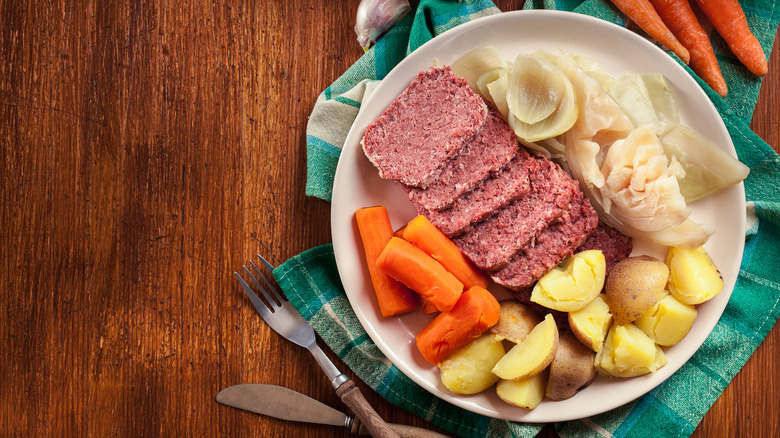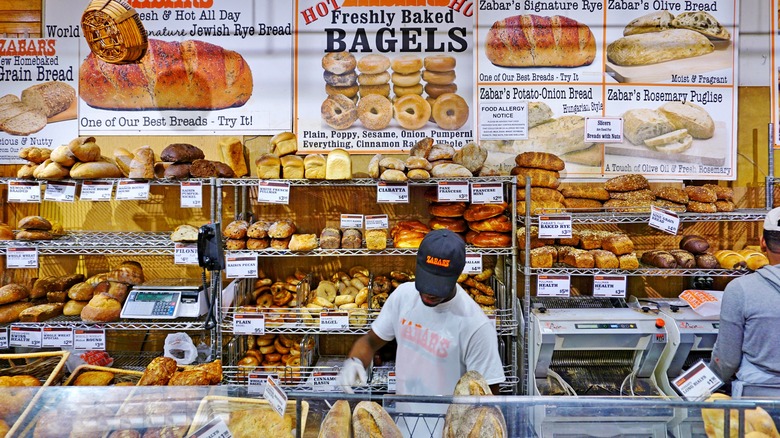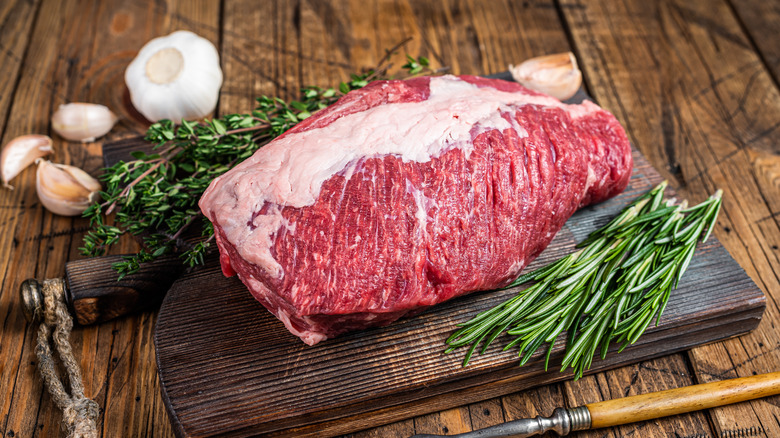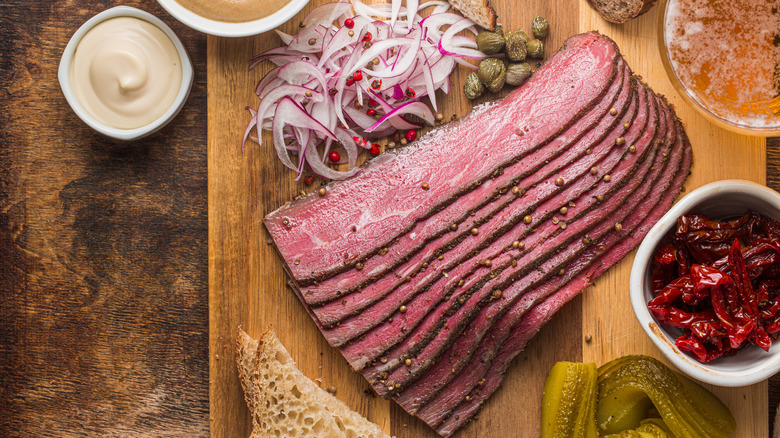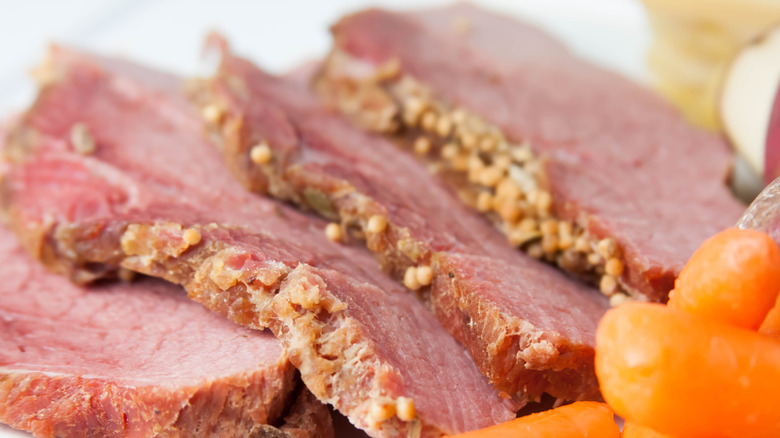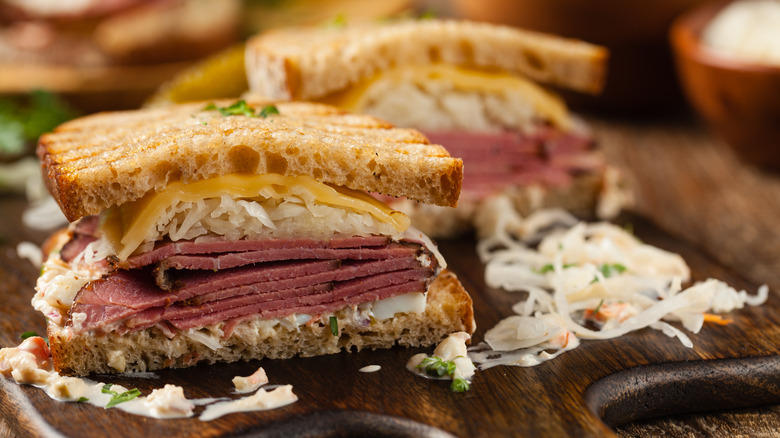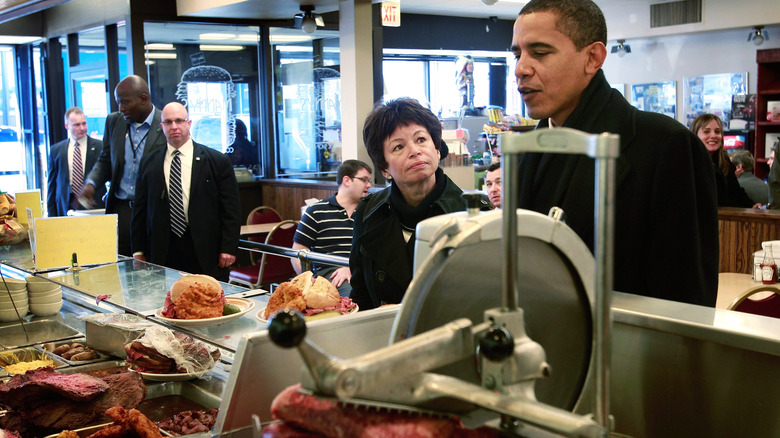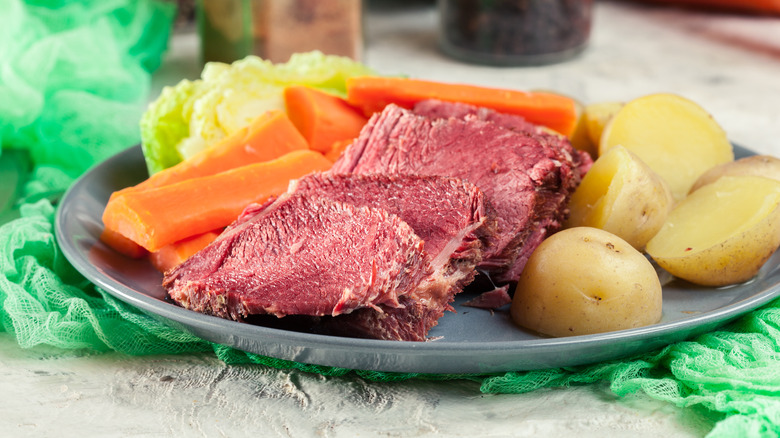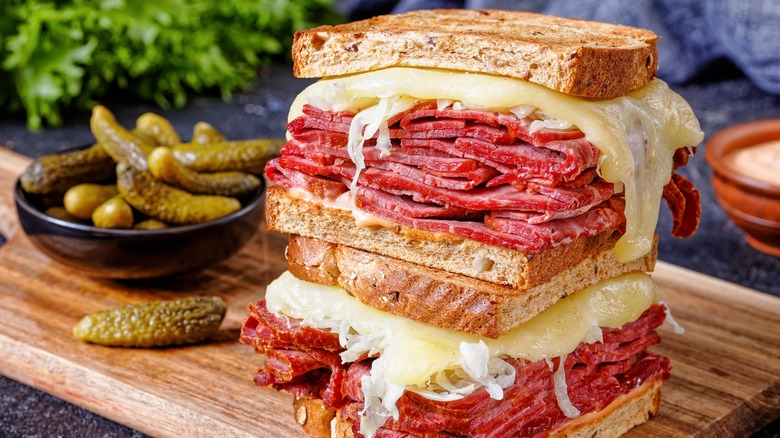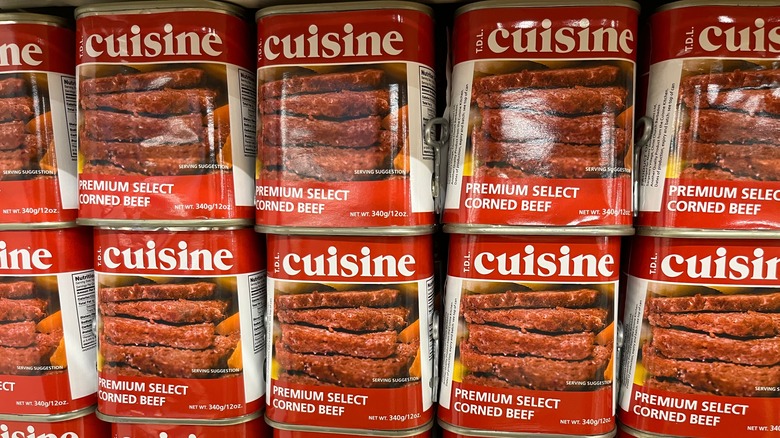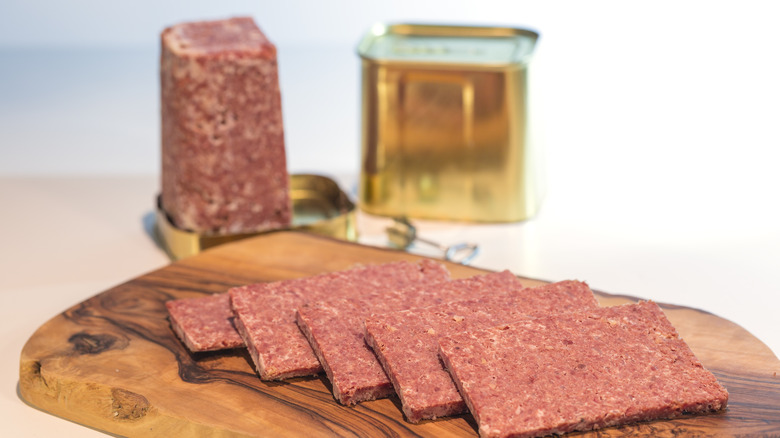What Exactly Is Corned Beef?
Corned beef might seem synonymous with Saint Patrick's Day, but in reality, there's a lot less Irish and a lot more Jewish about corned beef than you might think.
From its origins in the Irish Middle Ages, when Food & Wine says it was seen as a food fit for kings (and not for the riff raff who were breaking their backs to produce it as tenant farmers) to its metamorphosis into the somewhat questionable "bully beef" — a canned version that provided much-needed sustenance to soldiers on the front during both World Wars, corned beef has a long and convoluted history (via Delishably). Was it invented in Ireland or on the Lower East Side of Manhattan? Is it actually Irish or is it Romanian? Is there actually corn in it? And do the Irish actually eat it on Saint Patrick's Day?
For the answers to these questions and more, read on. Corned beef will soon hold no secrets for you.
Corned beef is not that common in Ireland
While Irish-Americans are certainly gung-ho about corned beef (as well as other St. Paddy's Day traditions like green glitter and green beer), this stands in stark contrast with their homeland, where corned beef is far from as common as you'd think (and where, by the way, beer is amber or brown, not green.) Indeed, according to the Smithsonian, beef is not all that commonplace in the traditional cuisine of Ireland, where, historically, cattle were used not for meat, but for fieldwork or dairy production. Cows were usually only slaughtered for food once they were no longer able to do their assigned jobs.
In the time of tribal chieftains, the size of your cattle herd was a sign of your power. To slaughter one before it was necessary would have been madness — something that European Cuisines compares to setting money on fire.
So while European Cuisines says that salted or cured beef is indeed an Irish tradition dating back as early as 800 AD, with its first mention appearing in the 12th century poem "The Vision of MacConglinne," it was perceived as a luxury item, consumed only by the rich, like the king evoked in the poem, or, later, by foreigners who imported the high-quality product from Ireland. It was far from the rustic peasant fare we think of when we serve up a heaping plateful to soak up all that St. Paddy's Day beer.
Beef in general — and corned beef in particular — only became common in Ireland with the arrival of the English
While cattle have indeed long been present in Ireland, it wasn't until the conquest of Ireland by the English that beef became common in the region, according to Food & Wine. The British had been eating beef since Roman times and had developed quite a taste for it. Given the relatively small size of their island, however (in contrast with their beefy appetites), the Brits took advantage of their conquest of Ireland, Scotland, and even the North American colonies to raise cattle for slaughter. This meant that the Irish were soon farming more and more beef — but they were far too poor to partake in any of it.
According to the Smithsonian, the Cattle Acts of 1663 and 1664 were what truly spurred the Irish corned beef industry (via Technological University Dublin). The Acts forbade the export of live cattle from Ireland to Britain. Thanks to easy access to inexpensive, high-quality salt, which was taxed at a lower rate in Ireland than in England, the Irish were able to export huge amounts of salted beef to England, France, and the colonies.
There's nothing corn-y about corned beef
Despite what its name may lead you to believe, the secret to delicious corned beef isn't corn but salt. Indeed, Irish corned beef is a preserved meat product, made according to tradition by curing the meat in a large quantity of salt. The term corned beef was invented by the British in the 17th century, according to the Smithsonian: a reference, not to corn, but to the corn-sized salt crystals applied to the meat. This first iteration of the classic we all know and love today, the Smithsonian asserts, was saltier than it was beefy, but it was certainly a predecessor to the corned beef you see on modern tables.
These days, corned beef is a bit of a misnomer, at least when it comes to the contemporary iterations of the product. While giant "corns" of salt were indeed used in the original recipe, today, according to Westchester Magazine, salt brines are far more common. This also allows you to add flavor by way of spices such as allspice, mustard, coriander, pepper, cloves, or bay, according to Simply Recipes.
Corned beef and cabbage is an Irish-American tradition
Corned beef is less common in Ireland than you'd think, but it's certainly present. That said, one thing is for sure: the pairing of corned beef and cabbage is absolutely an Irish-American tradition.
Despite the popularity of Irish corned beef beginning in the 17th century, according to Food & Wine, most locals couldn't afford the luxury product. Indeed, European Cuisines notes that many Irish tenant farmers were raising and producing corned beef for export without ever having had a morsel of the sought-after meat pass between their lips. If the Irish could afford meat, it was usually pork, and special occasion meals on holidays like Easter, for example, saw cabbage paired, not with corned beef, but with salt pork or bacon.
Cut to the 1845 potato blight and resulting famine, which led about a million Irish people to leave the country, with many of them settling in the U.S. (via History). It was there that they finally began to make enough money to purchase corned beef (per The Kitchn, in America, the traditional Irish staple of pork bacon was too expensive for the new immigrants). By cooking local corned beef with familiar (and inexpensive) cabbage, they created the dish that has since become an Irish-American classic.
Back in Ireland, according to European Cuisines, one does occasionally find corned beef paired with cabbage on St. Patrick's Day, but pubs dishing it up are generally doing it for the tourists.
Corned beef might have some Jewish influence
While corned beef is certainly an Irish product — and corned beef and cabbage is certainly an Irish-American tradition — there may be one more community to thank for its popularity: the Jewish one.
Indeed, when the Irish first emigrated to the U.S. in the mid-19th century, they often found their way to the Lower East Side of Manhattan, an area that also welcomed Jewish immigrants (via My Jewish Learning). According to the essay "Irish Corned Beef: A Culinary History," evidence in popular songs from the turn of the 20th century indicates that the two communities felt a bond with each other. Westchester Magazine says that Irish immigrants began eating the Jewish version of corned beef at delis in New York City. It was this iteration of corned beef — and not the expensive exported stuff from their native Ireland — that found its way into the pots of the newly arrived Irish, according to the Smithsonian.
Corned beef comes from the brisket of the cow
The corned beef that we consume in the U.S. was inspired by the corned beef of Jewish butchers and is thus made with brisket: a cut hailing from the front or breast area of the cow, according to the Smithsonian. The corning or salting process transforms this tough yet flavorful cut into an ultra-tender piece of meat. It's no wonder this dish is so beloved.
But brisket is not the cut used for all corned beef. In Ireland, tradition called for silverside, a cut from the hindquarters of the animal. It's named for the silvery membrane that covers it, according to Simply Beef and Lamb. While this exact cut doesn't exist in the U.S. due to differences in butchery techniques, it vaguely corresponds to the American round, according to European Cuisines.
Tradition aside, the fact is that any tough, sinewy cut of beef could technically be transformed into corned beef, including, according to the Spruce Eats, the aforementioned round, or, per New England Today, the rump or tongue.
It's similar to — but not the same as — pastrami
The Jewish influence on the corned beef of today leads many to wonder about the differences between corned beef and another beefy Jewish deli counter offering: pastrami.
Per Spend with Pennies, the main difference between the two is the cut: corned beef, the outlet asserts, hails from the brisket, while pastrami comes from the deckle, a cut found in beef shoulder. Eater echoes this distinction, noting nevertheless that these days, pastrami can indeed be made with brisket, adding a level of cloudiness to this reasoning.
Perhaps more important than the cut used to make them is that the two beef products are seasoned and prepared differently. While Eater asserts that both begin with the same brine of salt and spices tinged with coriander, bay, and juniper, after brining, pastrami is coated with a spice mix that may contain black pepper, coriander, mustard seeds, fennel seeds, and occasionally fresh garlic, while corned beef is left plain. And whereas pastrami is cooked by smoking over hardwood, corned beef is stewed or boiled, making pastrami the far more flavorful of the two.
Corned beef is available in red and gray varieties
Within the wider category of corned beef, two iterations exist, differentiated by color: either red and gray. And while the latter might not sound particularly enticing, gray might actually appeal more to modern consumers looking for less processed offerings, a desire that, according to Science Direct, is indeed on the rise.
Red brisket is cured with a curing salt called Prague powder, which contains sodium nitrite, according to The Spruce Eats. This substance is a food additive and preservative that is used to keep cured meats fresh, but that may be linked to blood vessel damage and heart disease, according to the Mayo Clinic, and has been listed as a probable carcinogen by the World Health Organization.
The gray, version, meanwhile, which New England Today dubs the "authentic New England variety," is not cured with nitrite. It doesn't have the bright color of the red variety, as nitrites give red corned beef its distinctive hue, but it's just as flavorful.
Corned beef is the main ingredient in a Reuben sandwich
Aside from the classic pairing of corned beef and cabbage, the dish with which corned beef is most frequently associated is a Reuben. The sandwich (which boasts a somewhat contested origin story — and given its popularity, we can't say we're surprised) features corned beef piled on rye bread and smothered with sauerkraut, Swiss cheese, and Russian dressing. It's a staple of New York's Jewish delis, and it's not hard to see why.
According to Olivia's Cuisine, a true Reuben boasts a pleasant touch of heat thanks to the addition of horseradish and hot sauce to the mayo-ketchup hybrid Russian dressing. This is a stark contrast to the sweeter flavor imparted by the similar Thousand Island, to which pickled relish is added. Swap the corned beef for pastrami, and you've got yourself a Rachel, or opt instead for turkey for a lower-calorie variation on the theme.
It's a presidential favorite
Like the cheeseburger, corned beef has a long history of appealing to folks on both sides of the tracks — while Irish immigrants were enjoying corned beef and cabbage on the Lower East Side of Manhattan, Abraham Lincoln was tucking into the very same dish at his inaugural luncheon (via Our White House). Grover Cleveland was a fan, too, in fact, according to the Cape Cod Times, Cleveland was wandering the White House halls one afternoon when he caught the scent of corned beef and cabbage coming from the servants' kitchen and begged to have his meal swapped out for the one the servants were having.
The presidential love of corned beef may go back even further than that — according to the official website of Mount Vernon (the long-time home of president George Washington), First Lady Martha Washington often served cold corned beef for breakfast.
Modern-day presidents enjoy corned beef, too, in fact, Barack Obama was famously embroiled in the "Mayogate" scandal after he was accused of ordering a corned beef sandwich with mayonnaise (which evidently you Just. Do. Not. Do.) The scandal ended when someone from the Obama White House emailed enraged blogger David Sax, claiming that Obama had, in fact, ordered a corned beef sandwich with mustard. The nameless informant then threw U.S. Representative Kendrick Meek under the bus, claiming that his sandwich was the one with mayo (via Jewish Telegraphic Agency).
The majority of corned beef is sold around St. Patrick's Day
Every holiday has its favorite meats ... except maybe World Vegan Day and Halloween. Every other holiday, though, is a meat-fest. In the United States, most turkeys are sold around Thanksgiving and Christmas, and most of the corned beef is sold around St. Patrick's Day. In fact, corned beef isn't nearly as popular at other times of the year and some retailers worry about ordering too much of it, lest no one wants the stuff after March 17.
According to Supermarket News, the grocery chain A&P says 85 to 90% of its corned beef sales happen in the week prior to St. Patrick's Day. Retailers often reduce the price of corned beef around this time, in the hope that customers will also buy their cabbage and beer at the same time.
An exception was the St. Patrick's Day holiday season of 2022, when many retailers reported they weren't planning to sell corned beef at all — like so many other food products, the wholesale price of those typically low-cost vacuum packs of corned beef was up by $1 a pound over the previous year. One retailer told CBS News that his corned beef order in 2021 cost around $475, but in 2022 the price was up around 40% to roughly $800. Like other retailers, he decided not to carry corned beef for the 2022 St. Patrick's season, leaving many locals scrambling for a substitute.
In 1965, astronaut John Young smuggled a corned beef sandwich onto Gemini III
If you grew up during the heyday of the American space program, you know that astronauts eat Tang and freeze-dried ice cream. And other things. Generally speaking, though, in zero gravity food has to be well-contained so floating crumbs aren't mucking up the equipment and poking astronauts in the eyeball.
Evidently, astronaut John Young missed that memo because, in 1965, he smuggled a corned beef sandwich onto Gemini III, a five-hour, three-orbit flight that represented the first manned mission of Project Gemini (via NASA). According to NASA, Young stashed the sandwich in the pocket of his space suit and, about two hours into the mission, offered some to fellow astronaut Gus Grissom.
NASA is notably diplomatic about the incident in its own retelling of the tale, but according to Atlas Obscura, Young was in deep doo doo when he returned to Earth — partly because he was supposed to be testing the freeze-dried astronaut food NASA had spent a fortune developing, not eating corned beef sandwiches, and partly because of the aforementioned floating crumb problem. After the incident, Young received the first-ever reprimand for a NASA astronaut, and later came to regret the stunt. History loved it, though, so much that today you can view a replica of Young's corned beef sandwich (preserved in resin) at the Grissom Memorial Museum in Indiana.
Corned beef is terrible for you
If you were paying attention when your doctor last lectured you about healthy eating, then you know beef in general is not super great for you. In fact, in 2012 a Harvard School of Public Health study found that people who eat a lot of red meat have a higher risk of developing coronary heart disease, type 2 diabetes, and certain cancers. Oh and death. Let's not forget the 13% increased risk of death.
Corned beef has all the bad of regular beef, plus some extras. Because it's brined, it has a high sodium content — in fact, according to Healthline, a 3-ounce serving of corned beef delivers 827 mg of sodium, which is roughly 34% of your recommended daily allowance. Sodium, in case you need a reminder, is especially bad if you have high blood pressure.
Alas, the corned beef sold in supermarkets is also a processed meat, given that it usually contains sodium nitrite to keep it fresh and prevent the growth of bacteria. And according to that same Harvard School of Public Health study, a daily serving of processed red meat increases your risk of death by about 20%.
It's not all bad ... there are some good things in that 3-ounce serving of corned beef, too, like 15 grams of protein, 27% of your daily vitamin B12, 10% of your iron, and 40% of your selenium, the latter of which is important for a healthy thyroid.
In terms of shelf life, it's practically a Twinkie
Most uncooked meats have a shelf life that ends roughly two days before you get around to cooking them, but uncooked, vacuum-packed corn beef remains unnaturally fresh for an unnaturally long period of time. In fact, according to Harris Ranch Beef, corned beef keeps for 60 days from the date of manufacture, which means you could buy your corned beef in late January and it would still be fresh enough to eat by the time St. Patrick's Day rolls around. Do check the sell-by date, though, just in case the corned beef you bought was sitting around on the shelf for a few weeks before you put it in your shopping cart.
Also, remember that the 60-days rule only applies to corned beef in an unopened package with a use-by date. Anything else, including corned beef you make yourself, should be eaten within five to seven days (via the University of Minnesota Extension). If you're going to keep it longer than that, you should drain it, wrap it, and keep it in the freezer. And cooked corned beef only lasts three or four days in the fridge, so don't wait to eat your leftover corned beef sandwiches.
Canned corn beef is another story altogether — that stuff will survive the apocalypse. According to Still Tasty, the canned stuff keeps its quality for three to five years, though it will still be safe to eat long after the fall of civilization.
Corned beef was a staple during World War II
During World War II, people got used to making due with very little. According to the Oregon Secretary of State, items that were considered important to the war effort — like coffee, butter, canned goods, meat, and (for some reason) sugar — were rationed so people couldn't just go down to the grocery store and buy up everything on the shelf, you know, like that one time in recent memory when there was no toilet paper. Because both meat and canned goods were rationed, people had to make their meager rations go a long way, hence the popularity of "hash" and other recipes that contained very little meat and quite a lot of healthy stuff (basically, the opposite of the way most Americans like to eat today).
According to People's Collection Wales, a popular Welsh ration recipe used flour, grated onions, eggs, and milk to stretch a six-ounce portion of corned beef into eight corned beef fritters, enough to serve a large family provided there was also some fresh produce on hand. In an archived story preserved by the BBC, a woman who lived through World War II remembered a 2-ounce per person ration on corned beef, which she would turn into a full meal by making a hash. She wasn't the only one; in fact, corned beef hash owes much of its popularity today to those enterprising cooks of the 1940s (via the Nibble).
